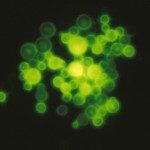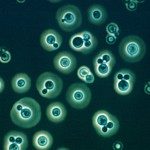Link to Pubmed [PMID] – 15686569
Mol. Microbiol. 2005 Feb;55(4):1259-71
Biofilm is the predominant type of microbial development in natural environments, and potentially represents a major form of resistance or source of recurrence during host infection. Although a large number of studies have focussed on the genetics of bacterial biofilm formation, very little is known about the genes involved in this type of growth in fungi. A genetic screen for Candida glabrata Biofilm mutants was performed using a 96-well plate model of biofilm formation. Study of the isolated mutant strains allowed the identification of four genes involved in biofilm formation (RIF1, SIR4, EPA6 and YAK1). Epa6p is a newly identified adhesin required for biofilm formation in this pathogenic yeast. EPA6 and its close paralogue EPA7 are located in subtelomeric regions and their transcription is regulated by Sir4p and Rif1p, two proteins involved in subtelomeric silencing. Biofilm growth conditions induce the transcription of EPA6 and EPA7: this is dependent on the presence of an intact subtelomeric silencing machinery and is independent of the Mpk1p signalling pathway. Finally, the kinase Yak1p is required for expression of both adhesin genes and acts through a subtelomeric silencing machinery-dependent pathway.








